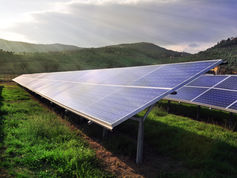Spurring Solar Development in Thailand
- Otto Gunderson

- Aug 1
- 4 min read
Despite solar representing the cheapest form of electricity in Thailand since 2022, the roadblocks to solar representing a substantial share of Thailand's energy matrix remain prevalent. This is particularly surprising because these solar projects, even when incorporated with batteries, represent a more economic alternative to thermal plants. A report from BloombergNEF found that a solar project with 4 hours of storage will be able to compete with existing thermal power plants this year.
Despite low current levels of adoption, the reduced cost of solar in comparison to other forms of energy indicates that even in a Bloomberg NEF base-case scenario, solar energy would provide ⅔ of electricity generation by 2050.
Unfortunately, the current deployment of solar in Thailand is less than 4 GW. This represents a fraction of the amount that will be required for Thailand to reach net zero. An article published by Dialogue Earth puts the scale of solar needed to meet net zero by 2050 at around 250 GW.
It is important to note that the increased adoption of solar alone will not be able to replace traditional fossil fuels. To counteract intermittency issues, many of these new systems will need to incorporate battery storage. Energy storage auctions and increasing the number of small-scale battery systems were found to be significant factors in reducing Thailand's reliance on imported LNG.
In conversation with Dr. Chariya Senpong at the Thailand Solar Fund, she outlined the status of solar adoption across the country. Most notably, she pointed to the growing market of rooftop solar due to the limitations of the size of solar farms. One of the immediate ways in which Thailand could develop its solar industry is through a Power Development Plan (PDP) that encourages the growth of solar projects. Perhaps the most effective way in which this can be accomplished is through a net metering policy to allow for excess clean energy to be sold back into the grid.
While the PDP certainly has the potential to increase the share of solar energy, it will not be enough to transition the country to net zero. By 2037, the end of the timeline for the new plan, the PDP estimates only 11% of the energy matrix will be solar. Unfortunately, the same plan maintains a share of natural gas for electricity generation at over 40% at the same time.

A written interview with Ember Energy Analyst Shabrina Nadhila provided regional context on what lessons Thailand could learn from neighboring countries as it seeks to expand its solar production. These include the substantial feed-in tariffs and policy direction that prompted the growth of utility-scale solar development in Vietnam. Additionally, Malaysia has utilized competitive large-scale solar tenders to reduce costs and improve quality. By adopting lessons from both Vietnam and Malaysia, Thailand can quickly expand its utility-scale solar industry.
The market for PV manufacturing has the presence of both localized and international companies. As Nadhila explained, the domestic manufacturers are reducing import dependency as well as shortening supply chain strains. However, there is also a strong presence of Chinese corporations that see manufacturing facilities in Thailand as a positive due to the financial incentives and location. Rather than viewing this as a one-or-the-other approach, Nadhila writes that the mix of domestic and imported panels has been crucial in creating a more stable and cost-effective panel supply for solar development.
There have thus far been significant steps made to see what a renewable-based energy matrix may look like in Southern Thailand. A report on the potential of clean energy to provide the province of Krabi with 100% renewable energy offers several insights into how the country can adopt a green energy matrix. The first is prioritizing renewable energy entering the grid over fossil fuels. Additionally, proper economic incentives and grid improvements will prove crucial. This report presents case studies of several situations in which solar energy can provide a strong, reliable, and economically viable alternative to traditional energy sources. These include projects such as the Ruenmai Restaurant, which incorporated a combined floating and rooftop solar project with a payback period of 6 years. Other solar installations in both Krabi and neighboring provinces show the range of potential for solar. These include a market in Krabi, a school in Surat Thani, a hospital in Songkhla, and a hostel in Surat Thani.
These case studies seem to offer a physical demonstration of a report published by the International Energy Agency (IEA) on the potential of rooftop solar in the country. This report outlines how, if distributed PV generation were used on 10% of the estimated available rooftop space, the capacity would exceed the system's peak demand. It is now up to the Thai government to adopt policies and incentives that encourage all forms of solar energy. By taking lessons from neighboring countries and encouraging solar development, Thailand can take advantage of its least expensive form of electricity generation and reduce its reliance on fossil fuels.













Comments